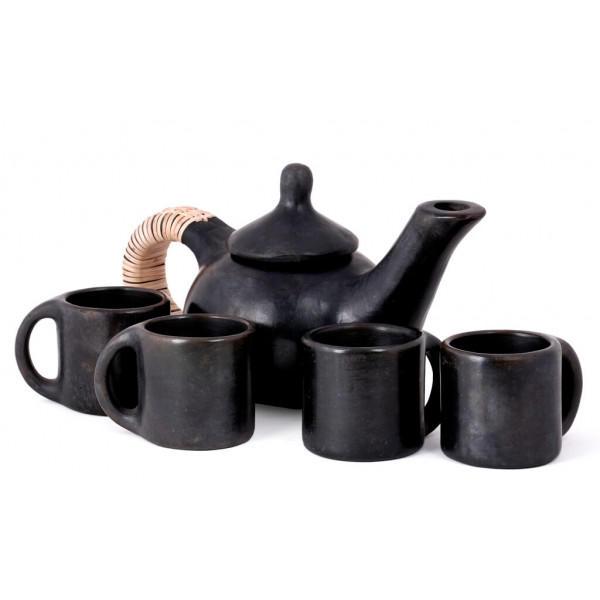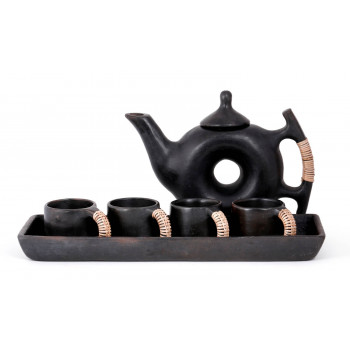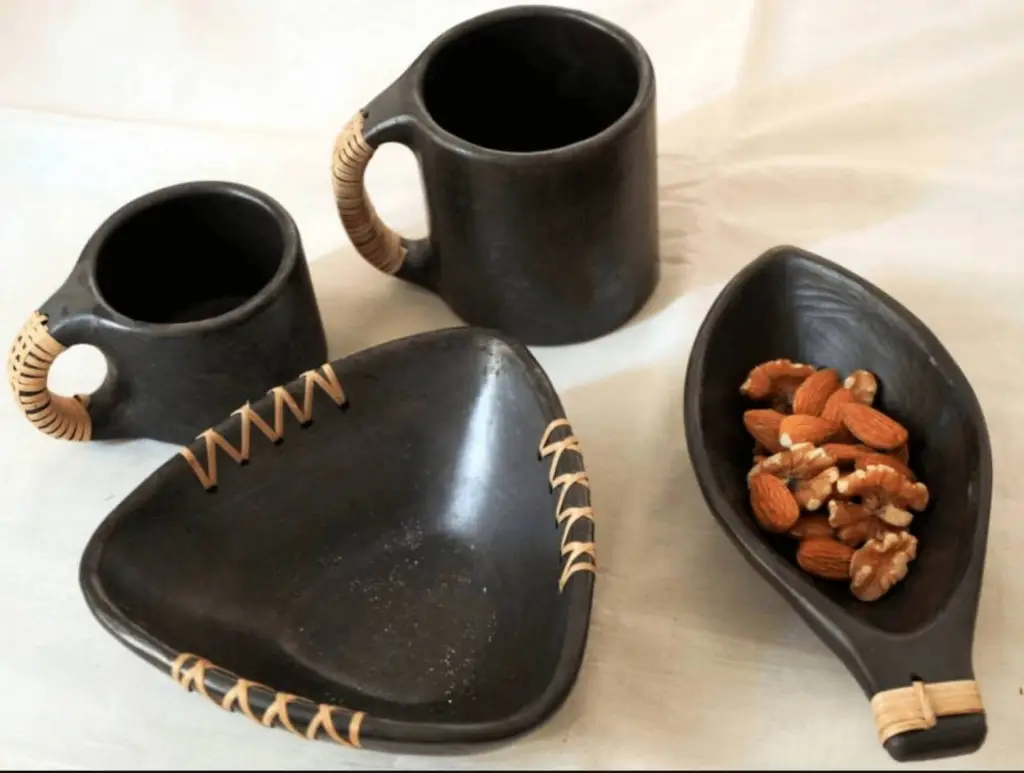ॐ श्री गुरुभ्यो नमः ॐ श्री शिवानन्दाय नमः ॐ श्री चिदानन्दाय नमःॐ श्री दुर्गायै नमः
Source of all Images in this Blog-post : Google Images : ‘Google Image Search’ will reveal the multiple sources of every single image shared here. For more details, kindly see ‘Disclaimer‘
Buy Manipur Black Pottery Online on Amazon India

Manipur’s Mystique: The Timeless Art of Longpi Black Pottery
In the lush green hills of Manipur, in Northeast India, there lies an ancient craft that not only embodies the region’s rich cultural heritage but also stands as a beacon of sustainability – Longpi pottery. This unique art form, originating from the small village of Longpi in the Ukhrul district, has been passed down through generations and continues to fascinate both art connoisseurs and environmental enthusiasts alike.
Originating from Longpi Khullen and Longpi Kajui villages near Manipur’s Ukhrul district, Longpi black pottery is a unique craft practiced predominantly by the Tangkhul community. This ancient art form is distinguished by its use of a special blend of ground black serpentine stone and unique brown clay exclusive to Longpi. Artisans skillfully hand-shape, polish, and sun-dry the pots before they undergo a bonfire heating process.
The striking black hue of Longpi ham pottery is achieved through reduction firing, while the lustrous sheen results from polishing with a local tree leaf. Remarkably, this pottery does not involve a potter’s wheel, making the process labor-intensive. Both men and women partake in this intricate craft, and encouragingly, the younger generation is showing a keen interest in sustaining this cultural legacy.
The Roots of Longpi Pottery
Longpi pottery, also known as ‘Loree Hamlei’, is an age-old craft practiced by the Tangkhul Naga tribe. The technique and style are distinct, with no potter’s wheel used in the process. Instead, artisans skillfully mold the clay with their hands, using an array of traditional tools. The key ingredients of Longpi pottery are weathered rock and serpentinite, locally sourced, which are mixed in a precise ratio to form the clay.

The Unique Crafting Process
The process of making Longpi pottery is as fascinating as the final product. Artisans meticulously hand-mold the clay, giving shape to a variety of items such as pots, pans, plates, and decorative items. Post-shaping, the pottery is polished with a smooth stone, imparting a unique shine to the surface. The most striking feature of Longpi pottery is its baking process. The pottery is fired in an open bonfire, not in a kiln, which results in its characteristic black color and sturdy form.

A Symbol of Sustainability
Longpi pottery is not just about aesthetics; it’s a testament to sustainable practices. The materials used are entirely natural, making the pottery eco-friendly. Furthermore, the lack of a potter’s wheel and kiln means lower energy consumption, thus reducing the carbon footprint of this craft. The durability of the products also ensures less waste, as they last for many years with minimal maintenance.
Buy Manipur Black Pottery Online on Amazon India

The Designs and Uses
The design of Longpi pottery is minimalist yet elegant, characterized by its black color and intrinsic patterns made by thin rice straw strands during the firing process. These designs reflect the rich cultural heritage of Manipur and the skill of its artisans. The pottery is versatile, used both for cooking – as it is heat-resistant – and as decorative pieces in homes and offices.

The Challenges and The Future
Despite its beauty and environmental benefits, Longpi pottery faces challenges. The limited availability of raw materials and the increasing demand for more modern cookware and decor items pose threats to this ancient craft. However, there is a growing awareness and appreciation for sustainable and handcrafted products, both in India and globally, which could help preserve and promote Longpi pottery.

Embracing the Craft
Longpi pottery is more than just a craft; it’s a legacy of Manipur’s rich culture and a shining example of sustainable art. By embracing and promoting such traditional crafts, we can contribute to preserving these ancient art forms while advocating for a more sustainable future. As we move towards a world that values the balance between beauty and sustainability, Longpi pottery stands as a remarkable testament to what we can achieve when we harmonize our artistic endeavors with nature’s principles.

The story of Manipur’s Longpi pottery is not just a tale of art and craft; it’s a narrative that intertwines the threads of cultural identity, environmental consciousness, and sustainable living. As you delve deeper into the world of traditional crafts, you uncover stories that have the power to inspire and change perspectives. Longpi pottery, with its deep roots and profound implications, is a perfect example of this.

Community Lifestyle in Longpi: A Harmony of Farming and Pottery
In Longpi, a community of about 200 families intricately weaves together the dual practices of farming and pottery-making, a lifestyle emblematic of their deep connection with both land and craft. These families, residing in the serene hills of Manipur, have masterfully balanced these activities, aligning them with the rhythm of the seasons.
Farming, primarily of rice and vegetables, dominates their routine during specific periods, while pottery-making occupies center stage at other times. This harmonious blend of agriculture and artisanal craft is not just a means of livelihood but a cultural rhythm that defines their daily lives, ensuring that the age-old traditions of Longpi pottery flourish alongside sustainable agricultural practices.

National Recognition for Longpi Pottery: A Rising Star in Indian Handicraft
Despite the logistical challenges inherent to its remote location, Longpi pottery has transcended geographical barriers to achieve national acclaim. This recognition underscores the unique appeal of the craft, with clients from various Indian states expressing a deep interest in these artisanal creations.
The increasing demand from a diverse clientele across the country is a testament to the universal appeal of Longpi pottery’s distinct aesthetic and sustainable ethos. This growing recognition not only celebrates the artistic value of the pottery but also highlights the rich cultural heritage of Manipur, bringing a local tradition to the national spotlight.

Transportation Hurdles of Longpi Pottery Artisans
Transporting Longpi pottery from the artisans’ hilly village to larger markets presents a formidable challenge. The terrain in and around Longpi, characterized by steep hills and limited infrastructure, makes even short journeys time-consuming and arduous.
These logistical difficulties impact not only the speed and efficiency of reaching broader markets but also add to the cost and complexity of distribution. Despite these obstacles, the determination and ingenuity of Longpi artisans in overcoming these hurdles to share their craft with a wider audience is a testament to their dedication and the enduring appeal of their art.
Embracing the Legacy and Future of Longpi Pottery
In conclusion, Longpi pottery from Manipur is not just a form of art; it is a resonant story of cultural pride, environmental stewardship, and communal resilience. This ancient craft, with its deep roots in the hills of Manipur and in the hearts of the Tangkhul community, stands as a testament to the power of traditional practices in the modern world.
As we appreciate the beauty and sustainability inherent in each piece of Longpi pottery, we also recognize the importance of preserving such crafts. By supporting these artisans and their art, we contribute not only to the survival of a priceless cultural heritage but also to the promotion of a more sustainable and mindful way of life.
The story of Longpi pottery is a call to action, inviting us all to cherish and nurture the delicate balance between tradition and innovation, beauty and utility, past and future.
Buy Manipur Black Pottery Online on Amazon India
***********************************
Shopping : Buy Manipur black pottery online by clicking on the following images
Shopping : Buy Manipur black pottery online by clicking on the above images
******************************












